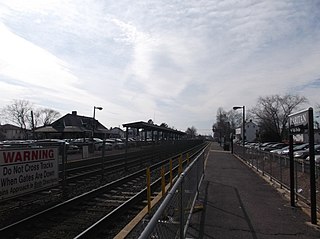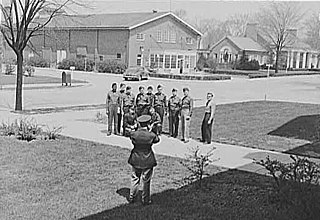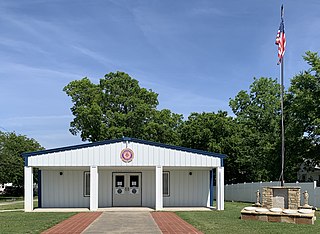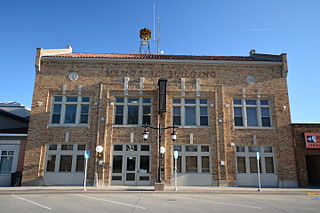
Raritan is an NJ Transit railroad station on the Raritan Valley Line, in Raritan, Somerset County, New Jersey, United States, north of the town center on Thompson Street. The station building is south of the tracks in the main parking lot and was built in the early 1890s. There are also three other small lots for this station.

The Florida Theatre is a historic American movie theater located in Jacksonville, Florida. Opened in April 1927, it was added to the U.S. National Register of Historic Places on November 4, 1982. On April 18, 2012, the AIA's Florida Chapter placed the building on its list of Florida Architecture: 100 Years. 100 Places.

Fort Benjamin Harrison was a U.S. Army post located in suburban Lawrence Township, Marion County, Indiana, northeast of Indianapolis, between 1906 and 1991. It is named for the 23rd United States president, Benjamin Harrison.

The Union Mission Chapel-Historical Hall is an historic building at 5 Cedar Street in Taunton, Massachusetts. Built as a chapel in 1867, it has also served as a mission hall and museum, and housed the local American Legion chapter for many years beginning in 1926. The building, one of the few stone structures in the city, was added to the National Register of Historic Places in 1984.

There are 75 properties listed on the National Register of Historic Places in Albany, New York, United States. Six are additionally designated as National Historic Landmarks (NHLs), the most of any city in the state after New York City. Another 14 are historic districts, for which 20 of the listings are also contributing properties. Two properties, both buildings, that had been listed in the past but have since been demolished have been delisted; one building that is also no longer extant remains listed.

The Former First Baptist Church is a historic church building at 37 Main Street in Skowhegan, Maine. Built in 1842-44, this Greek Revival brick building is one of the few works attributable to a local master builder, Joseph Bigelow. It was used as a church until 1919, after which it was used as a community center, and then a VFW hall until 2009. It is vacant, with plans to establish a performance and meeting venue; it was listed on the National Register of Historic Places in 1991.

Academy Hall is a historic former school building at 785 Old Main Street in Rocky Hill, Connecticut. Built in 1803, it is a well-preserved example of a Federal style academy. It was listed on the National Register of Historic Places in 1977. It presently houses the Academy Hall Museum of the Rocky Hill Historical Society.

Hauschild's Hall is a historic building located in the West End of Davenport, Iowa, United States. It was listed on the National Register of Historic Places in 1983. The building was constructed around 1880 in the German section of the city. It is a three-story commercial building with a store front on the main level and four bays on the upper floors. The window openings in the upper floors feature brick segmental arches with keystones and brick sills. The building was constructed in brick, but has subsequently been covered with siding. The cornice level of the building also features decorative brickwork that has also been covered.

The Newport American Legion Community Hut is a historic log meeting hall in Remmel Park, north of Remmel Avenue, in Newport, Arkansas. It is a single-story structure, with a gable roof, and a front porch with a shed roof supported by log columns. The interior has retained all of its exposed log framing. A storage building, also built of logs at the same time, stands nearby. The hall was built in 1934 as part of the improvements to Remmel Park, and was designed to serve both the local American Legion chapter and the community.

The Cushing American Legion Building is an American Legion hall located at 212 S. Noble in Cushing, Oklahoma. The building was built in 1924 to serve as a meeting place for American Legion Post 108, which was organized by World War I veterans. The Mission Revival building features a raised parapet and a colonnade of square columns in front of the entrance. The American Legion Post hosted social events for veterans and sponsored observances on Armistice Day and Memorial Day. The post expanded to include World War II veterans in the 1940s and hosted meetings of other local groups throughout the 1940s and 1950s; the American Legion has continued to meet at the post into the 21st century.

Centerville station, now known as the Appanoose County Post 526 VFW Hall, is an historic train station located in Centerville, Iowa, United States. The Chicago, Burlington and Quincy Railroad (CB&Q) bought the Keokuk & Western Railroad in 1903. Centerville served as a dividing point on the line and by 1910 the people in the town started to plan for a larger station. Its architect is unknown, but the depot was probably designed by a CB&Q architect using fairly standard plans that were used by the railroad at the time. Construction of the Prairie School style building began in July 1911 and it was completed in February of the following year. Local contractor B.S. Staley built the building. The building was used by the CB&Q until 1982. It was bought by the Appanoose County VFW post for their meeting hall in 1990 and it was listed on the National Register of Historic Places in 2003 as the CB&Q Passenger Depot.
Frederick Albert Hale was an American architect who practiced in states including Colorado, Utah, and Wyoming. According to a 1977 NRHP nomination for the Keith-O'Brien Building in Salt Lake City, "Hale worked mostly in the classical styles and seemed equally adept at Beaux-Arts Classicism, Neo-Classical Revival or Georgian Revival." He also employed Shingle and Queen Anne styles for several residential structures. A number of his works are listed on the U.S. National Register of Historic Places.

The Alpha Tau Omega Fraternity House, also known as the ATO House, is a Colonial Revival building in Reno, Nevada that was built in 1929. It was listed on the National Register of Historic Places in 2004.

The Union Hotel is a historic hotel building at 254 Main Street in the Union village of Wakefield, New Hampshire. Built in 1855 and repeatedly enlarged, it is one of only two surviving 19th-century railroad hotels in the town. It was operated until 1960, and for many years housed the local VFW post. The building was listed on the National Register of Historic Places in 1989. It is now home to the Greater Wakefield Resource Center.
The Sink-Crumb Post No. 72 American Legion Hut is a historic American Legion hall at Second and Cherry Streets in Knobel, Arkansas. It is a single-story cypress log structure, with a corrugated tin roof, a Rustic form that was typical of Legion halls of the 1930s. The hall was built in 1933–34 with funding from the Federal Civil Works Administration for the local American Legion chapter, which had been founded in 1931, and has served as a center for its activities since then.

The Old Town House, also known as the Union Town House, is a historic government building at 128 Town House Road in Union, Maine. Built in 1840, it served the town for many years as its town hall, and as one of its major social venues. It is now owned by the local historical society, which operates it as a community meeting place. It was listed on the National Register of Historic Places in 2001.

Sac City Monument Square Historic District is a nationally recognized historic district located in Sac City, Iowa, United States. It was listed on the National Register of Historic Places in 2015. The square consists of the General Sherman Hall (1892), Memorial Statue (1894), the American Legion Hall (1922), four World War II era Howitzers, and three granite tablets that commemorate the lives of the soldiers from Sac County who fought in World War I, World War II, the Korean War, and the Vietnam War. The Vietnam War tablet does not contribute to the historic district because it is a more recent installation.

The Soldiers and Sailors Memorial Building in West Newbury, Massachusetts is a historic American Civil War memorial building at 363 Main Street. Built in 1900, it is a distinctive local example of Gothic Revival architecture. It has served as a meeting place for veterans organizations and housed the local public library for 12 years. It was listed on the National Register of Historic Places in 2016.

Memorial Building, also known as Dyersville City Hall, is a historic building located in Dyersville, Iowa, United States. When this structure was completed in 1929 it housed the following functions: police department, fire department, municipal offices, post office, library, community hall, and gymnasium. It replaced the 1893 city hall at the same location that housed all those functions except the library and gymnasium. Its function as a veteran's memorial was overseen by the American Legion, which also was initially located here. The Legion, fire station and post office have subsequently relocated to other facilities. The previous city hall had been damaged in a fire in 1928. The Waterloo, Iowa architectural firm of Ralston and Ralston designed the two-story brick Colonial Revival style building to replace it. Raymond Klass of Louisburg, Wisconsin was the contractor who built the new structure. The building was completed on December 12, 1929, for just over $40,000. It was listed on the National Register of Historic Places in 2013.

Nisei Memorial VFW Post 8985 was founded in 1947 by Japanese-American World War II veterans of the 442nd RCT and the Military Intelligence Service in Sacramento, California. Its members would form the first of 14 segregated Nisei VFW posts chartered in California. The post's clubhouse, originally built as a restaurant, was purchased with assistance from the local JACL in 1955, and is now the last remaining property associated with what was once Sacramento's historic Japantown.




















